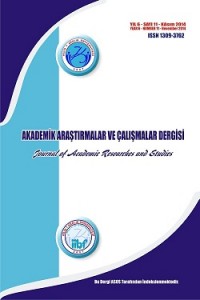DETERMINING FACTORS OF TRADE FLOWS BLACKSEA ECONOMIC COOPERATION (BSEC) REGION: A PANEL GRAVITY MODEL
Öz
After the receding of the atmosphere of the cold war, suspicion and mistrust, the countries of Black Sea area have been able to undertake bold steps to be tightened the relationships among themselves. They come together and decided to how, in the age of globalisation of economies, valuable assets in their possession, such as geographical proximity, common history, cultural bonds and interdependence of their national economies could be efficiently employed for mutual benefit and prosperity. Foundation of the Black Sea Economic Cooperation (BSEC) bases on this intention. In this paper impacts of the gravitational factors on bilateral trade are investigated in case of BSEC region. The estimations of the panel gravity models reveal that economic size and population of the importer countries have a positive impact on trade volume, whereas the distance between them works on the opposite way.
Anahtar Kelimeler
Bilateral trade Black Sea Economic Cooperation (BSEC) Panel gravity
Kaynakça
- Anderson, J.E. (1979), “A Theoretical Foundation for the Gravity Equation”, American Economic Review, (93) 1, pp. 170-192
- Antonucci, D. and S. Manzocchi (2005), “Does Turkey have a Special Trade
- Relation with the EU? http://papers.ssrn.com/sol3/papers.cfm?abstract id=609881 Gravity Model Approach”,
- Armstrong, S. (2007), Measuring Trade and Trade Potential: A Survey, Asia
- Pacific Economic Papers, No. 368, Australia-Japan Research Centre, pp. 18
- Baier, S.L. and J.H. Bergstrand (2005), Do Free Trade Agreements Actually
- Increase Members’ International Trade?, Working Paper No. 2005-3, Federal Reserve Bank of Atlanta
- Batra, A. (2004), India’s Trade Potential: The Gravity Model Approach, Working Paper No. 151, Indian Council for Research on International Economic Relations, pp. 38
- Bergstrand, J.H. (1985), “The Gravity Equation in International Trade: Some Microeconomic Foundations and Empirical Evidence”, Review of Economics and Statistics, (67) 3, pp. 474-481
- Bikker, J.A. (1987), “An International Trade Flow Model with Substitution: An Extension of Gravity Model”, Kyklos, (40), pp. 315-337
- Bos, J.W.B. ve M. van de Laar, (2004) Explaining Foreign Direct Investment in Central and Eastern Europe: An Extended Gravity Approach, DNB Working Papers, 008, Netherlands Central Bank.
- Breuss, F. and P. Egger (1999), “How Reliable are Estimations of East-West Trade Potentials Based on Cross-section Gravity Analyses?”, Empirica, 26 (2), pp. 81-95.
- Bussiére, M. and B. Schnatz (2006), Evaluating China’s Integration in World Trade with a Gravity Model Based Benchmark, W. P. No. 693, European Central Bank, pp. 40
- Deardorff, A.V. (1995), Determinants of Bilateral Trade: Does Gravity Work in a Neo-classic World?, NBER Working Paper No. 5377, pp. 28
- Dikkaya, M. and M. Orhan (2003), “Economies of the Black Sea Economic Cooperation (BSEC) Countries and their Bilateral Trade”, Journal of Economic and Social Research, (6) 2, pp. 63-86.
- Egger, P. (2000), “A Note on the Proper Econometric Specification of the Gravity Equation”, Economics Letters, 66, pp. 25-31.
- Egger, P. (2005), “Alternative Techniques for Estimation of Cross-Section Gravity Models”, Review of International Economics, (13) 5, pp. 881-891.
- Hellvin, L. and L. Nilsson (2000), Trade Flows Between Trading Blocs: The Case of the EU’s Trade with Asia and NAFTA, Swedish Network for European Studies in Economics http://www.snee.org/filer/papers/36.pdf Business, Discussion Paper,
- Jayasinghe, S. and R. Sarker (2004), Effects of Regional Trade Agreements on Trade in Agrifood Products: Evidence from Gravity Modeling Using Disaggregated Data, Working Paper No. 374, Center for Agricultural and Rural Development, Iowa State University, pp. 37
- Kien, N.T. and Y. Hashimoto (2005), Economic Analysis of ASEAN Free Trade Area By Country Panel Data, Discussion Paper No. 05-12, Osaka School of International Public Policy, Osaka University, Osaka, Japan, pp. 20
- Martinez-Zarzoso, I. (2003), “Gravity Model: An Application to Trade Between Regional Blocs”, Atlantic Economic Journal, 31 (2), pp. 174-187
- Martinez-Zarzoso, I. and F. Nowak-Lahmann (2003), Augmented Gravity Model: An Empirical Application to Mercosur-European Union Trade Flows, Journal of Applied Economics, 4 (2), pp. 291-316
- Matyas, L. (1997), “Proper Econometric Specification of the Gravity Model”, The World Economy, 20 (3), pp. 363-8.
- Porojan, A. (2000), Trade Flows and Spatial Effects: The Gravity Model Revisited, University of Derby.
- Pöyhönen, P. (1963), A Tentative Model for the Volume of Trade Between Countries, Weltwirtschaftliches Archiv, 90, pp. 23-40
- Rojid, S. (2006), COMESA Trade Potential: A Gravity Approach, Applied
- Economics Letters, 13, pp. 947-951.
- Sayan, S. (1998), Could Regional Economic Cooperation Generate Trade Creation and Trade Diversion Effects without Altering Trade Policies of Members? Preliminary Results from a gravity Application to BSEC, Discussion Paper No. 98-10, Bilkent University.
- Simwaka, K. (2006), Dynamics of Malawi’s Trade Flows: A Gravity Model Approach, MPRA Paper No. 1122, pp. 12
- Tinbergen, J. (1962), An Analysis of World Trade Flows, J. Tinbergen (ed.): in Shaping the World Economy, New York: The Twentieth Century Fund.
- Windgren, M. (2006), Trade Potential, Intra-industry Trade and Factor Content of Revealed Comparative Advantage in the Baltic Sea Region, Discussion Papers No. 1034, The Research Institute of the Finnish Economy, Helsinki.
Ayrıntılar
| Birincil Dil | İngilizce |
|---|---|
| Bölüm | ARAŞTIRMA MAKALELERİ |
| Yazarlar | |
| Yayımlanma Tarihi | 25 Aralık 2014 |
| Yayımlandığı Sayı | Yıl 2009 Cilt: 1 Sayı: 1 |
Kaynak Göster
Bu eser Creative Commons Atıf-GayriTicari 4.0 Uluslararası Lisansı ile lisanslanmıştır.


